Studio visit: Studio Baxton
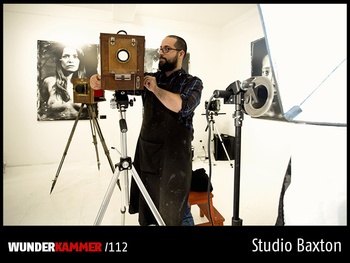
Studio Baxton is reinvigorating the 160-year-old wet collodion photography technique. The project by Silvano Magnone, Nicolas Lambert, and Vincent Bouchendhomme produces portraits of haunting, unearthly beauty. “Aesthetically, we are not used to seeing pictures like these. But these portraits move you.”
“You can do whatever you want, as long as you don’t smile,” Silvano Magnone grins. “The plates are not very photosensitive, and we have to expose them for a long time. A smile will turn into a strange grimace.” With a certain reluctance, we are pinned into a chair with a neck support that helps us to stay completely still for five seconds. We are surrounded by the extra warm glow of several lamps. “The support is actually the pedal of a drum kit, but it will do,” Magnone laughs. “Actually, I hated it too, being there in front of the camera, but it is the best way of experiencing how it feels to have your portrait taken with the wet collodion technique.”
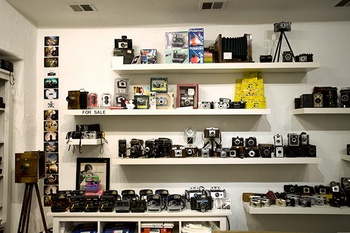
Studio Baxton saw the light of day seven months ago: it is a photo studio and a small shop dedicated to analogue photography, vintage processes, and experimental techniques. Silvano Magnone, Nicolas Lambert, and Vincent Bouchendhomme joined forces to run the project. The three friends – an Italian, a Belgian, and a Frenchman – aimed to master the wet collodion technique, and to introduce the public to analogue photography. Magnone and Lambert initiate us into the secrets of this 19th-century technique. The Frenchman Bouchendhomme is not in the picture today.
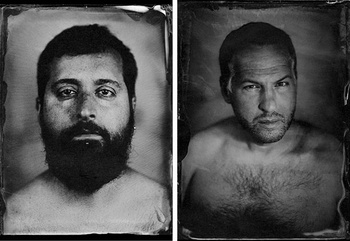
(Silvano Magnone & Nicolas Lambert © Studio Baxton)
Where does this new interest in old techniques come from? Nicolas Lambert: “People want something that feels more real than a file on their iPhone that they can copy over and over again. Here at Baxton, we create unique images on a glass (ambrotype) or aluminium (tintype) support, using original cameras and lenses. The end product that you hold in your hands is unique.”
Magnone: “A few days ago, I read an article that talked about the discovery of 150-year-old wet plates at the bottom of the ocean. After all those years you could still see the image. Have you ever tried to put your hard drive in a sink for five seconds and see what happens to your images? Yes, wet collodion is a fragile technique. When the plates fall, they break. But at the same time, they are so strong that the images can stay there forever. Even if they are 100 years old and surrounded by fish!”
Where does this new interest in old techniques come from? Nicolas Lambert: “People want something that feels more real than a file on their iPhone that they can copy over and over again. Here at Baxton, we create unique images on a glass (ambrotype) or aluminium (tintype) support, using original cameras and lenses. The end product that you hold in your hands is unique.”
Magnone: “A few days ago, I read an article that talked about the discovery of 150-year-old wet plates at the bottom of the ocean. After all those years you could still see the image. Have you ever tried to put your hard drive in a sink for five seconds and see what happens to your images? Yes, wet collodion is a fragile technique. When the plates fall, they break. But at the same time, they are so strong that the images can stay there forever. Even if they are 100 years old and surrounded by fish!”
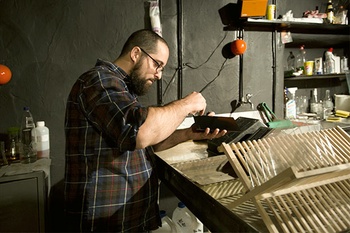
In the meantime, we are still sitting in front of the enormous camera that dates from 1895. The shot is being framed and the lens focused. We then head to the dark room to prepare the aluminium support. Collodion is poured over the plate, which then reacts with silver nitrate in a lightproof box. “We mix the chemicals ourselves,” Magnone says. “Wet collodion is something you can master, but at the same time you can’t. You know how to create a good image that is clean, but the day after you’ll do exactly the same and you won’t have the same result. It’s ephemeral.”
“The process is unstable,” Lambert adds. “You have to feel it. Sometimes you are not in the same frequency with the elements. We’re not only talking about the chemicals, the photographer’s blood pressure or change in the weather makes the product behave differently. So you see, really mastering the technique is impossible.”
“The process is unstable,” Lambert adds. “You have to feel it. Sometimes you are not in the same frequency with the elements. We’re not only talking about the chemicals, the photographer’s blood pressure or change in the weather makes the product behave differently. So you see, really mastering the technique is impossible.”
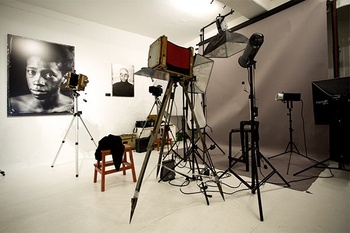
The exposed aluminium plates are loaded into a cassette and we return to the studio, where the process of framing and focusing starts all over again. The only difference being that a single photo will now actually be taken. And then there’s the magical moment in the dark room. Developer is poured over the exposed plate and the image appears.
“This portrait is unique,” Magnone says. “A one of a kind object and we do not even keep it. The original is for the person portrayed. Sometimes it’s not easy to give it away. The relationship you create with a person is really important.” How do people react when they see their likeness appear? “We have extraordinary moments with people who are looking at their image for the first time,” Lambert says. “They are impressed not only by the quality, but also by the strange relationship they have with the image. They discover themselves in a whole new way.”
“This portrait is unique,” Magnone says. “A one of a kind object and we do not even keep it. The original is for the person portrayed. Sometimes it’s not easy to give it away. The relationship you create with a person is really important.” How do people react when they see their likeness appear? “We have extraordinary moments with people who are looking at their image for the first time,” Lambert says. “They are impressed not only by the quality, but also by the strange relationship they have with the image. They discover themselves in a whole new way.”
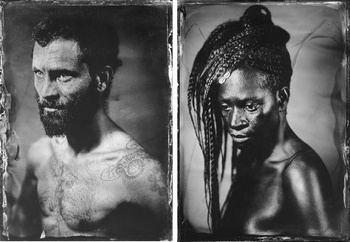
(© Studio Baxton)
“It helps that a tintype is a direct positive,” Magnone adds. “What you see is the same image as your reflection in the mirror but with different details. So in a way you feel like the portrait is more you.”
Lambert: “People who come here are often in search of themselves. Maybe that’s why a lot of clients want to pose naked or half-naked. Even if the subject is the face and the rest is blurry. Clothes can be a distraction.” “But we photograph people with their clothes on too,” Magnone grins. “This isn’t a nude project.”
Thank goodness for that.
Borough: Brussels
Activities: Studio Baxton organises exhibitions and workshops on alternative photographic processes. They also have a shop dedicated to analogue photography.
Info: Oud Korenhuis 29 place de la Vieille Halle aux Blés, Tu > Su 13.30 > 18.30, www.studiobaxton.com, www.facebook.com/studiobaxton
Photos © Heleen Rodiers
“It helps that a tintype is a direct positive,” Magnone adds. “What you see is the same image as your reflection in the mirror but with different details. So in a way you feel like the portrait is more you.”
Lambert: “People who come here are often in search of themselves. Maybe that’s why a lot of clients want to pose naked or half-naked. Even if the subject is the face and the rest is blurry. Clothes can be a distraction.” “But we photograph people with their clothes on too,” Magnone grins. “This isn’t a nude project.”
Thank goodness for that.
Borough: Brussels
Activities: Studio Baxton organises exhibitions and workshops on alternative photographic processes. They also have a shop dedicated to analogue photography.
Info: Oud Korenhuis 29 place de la Vieille Halle aux Blés, Tu > Su 13.30 > 18.30, www.studiobaxton.com, www.facebook.com/studiobaxton
Photos © Heleen Rodiers
Read more about: Expo
Fijn dat je wil reageren. Wie reageert, gaat akkoord met onze huisregels. Hoe reageren via Disqus? Een woordje uitleg.